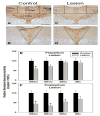Serotonin-specific lesions of the dorsal raphe disrupt maternal aggression and caregiving in postpartum rats
- PMID: 29653128
- PMCID: PMC5993625
- DOI: 10.1016/j.bbr.2018.04.008
Serotonin-specific lesions of the dorsal raphe disrupt maternal aggression and caregiving in postpartum rats
Abstract
The behavioral modifications associated with early motherhood, which include high aggression, caring for the young, and low anxiety, are all affected by acute pharmacological manipulation of serotonin signaling. However, the effects on all these behaviors of permanently disrupting serotonin signaling from one of its primary sources, the dorsal raphe nucleus (DR), have not been examined in detail. To address this, serotonin-specific lesions centered on the dorsomedial DR (DRdm; DR subregion strongly implicated in emotional behaviors) were induced at mid-pregnancy (day 15) or early postpartum (day 2) in rats using a saporin-conjugated neurotoxin targeting the serotonin transporter (Anti-SERT-SAP). Prepartum or postpartum Anti-SERT-SAP reduced DRdm serotonin immunoreactivity by ∼40-65%, and postpartum Anti-SERT-SAP also reduced it in the ventromedial and lateral wings of the DR, as well as in the median raphe. Serotonin-immunoreactive fibers were significantly reduced in the anterior hypothalamus, but not medial preoptic area, of lesioned dams. Pre- or postpartum lesions both greatly reduced maternal aggression, but while prepartum lesions did not affect later undisturbed maternal caregiving, the larger postpartum lesions prevented the postpartum decline in kyphotic nursing and reduced pup licking. Serotonin lesions did not affect pup retrieval, but the prepartum lesions temporarily increased maternal hovering over and licking the pups observed immediately after the disruptive retrieval tests. Dams' anxiety-like behaviors and litter weight gains were unaffected by the lesions. These findings suggest that DRdm serotonin projecting to the AH is particularly critical for maternal aggression, but that more widespread disruption of midbrain raphe serotonin is necessary to greatly impair maternal caregiving. Postpartum anxiety may rely more on other neurochemical systems or different midbrain serotonergic cell populations.
Keywords: Aggression; Anxiety; Lactation; Maternal behavior; Pregnancy; Serotonin.
Copyright © 2018 Elsevier B.V. All rights reserved.
Figures





Similar articles
-
Serotonin and motherhood: From molecules to mood.Front Neuroendocrinol. 2019 Apr;53:100742. doi: 10.1016/j.yfrne.2019.03.001. Epub 2019 Mar 13. Front Neuroendocrinol. 2019. PMID: 30878665 Free PMC article. Review.
-
Oxytocin interactions with central dopamine and serotonin systems regulate different components of motherhood.Philos Trans R Soc Lond B Biol Sci. 2022 Aug 29;377(1858):20210062. doi: 10.1098/rstb.2021.0062. Epub 2022 Jul 11. Philos Trans R Soc Lond B Biol Sci. 2022. PMID: 35858105 Free PMC article. Review.
-
Motherhood and infant contact regulate neuroplasticity in the serotonergic midbrain dorsal raphe.Psychoneuroendocrinology. 2017 Feb;76:97-106. doi: 10.1016/j.psyneuen.2016.10.023. Epub 2016 Nov 19. Psychoneuroendocrinology. 2017. PMID: 27898359 Free PMC article.
-
Oxytocin receptors in the midbrain dorsal raphe are essential for postpartum maternal social and affective behaviors.Psychoneuroendocrinology. 2021 Sep;131:105332. doi: 10.1016/j.psyneuen.2021.105332. Epub 2021 Jun 18. Psychoneuroendocrinology. 2021. PMID: 34182251 Free PMC article.
-
Postpartum inhibition of ovarian steroid action increases aspects of maternal caregiving and reduces medial preoptic area progesterone receptor expression in female rats.Horm Behav. 2017 Nov;96:31-41. doi: 10.1016/j.yhbeh.2017.08.007. Epub 2017 Sep 18. Horm Behav. 2017. PMID: 28882474
Cited by
-
The Dorsal Raphe Regulates the Duration of Attack through the Medial Orbitofrontal Cortex and Medial Amygdala.eNeuro. 2020 Oct 26;7(5):ENEURO.0331-20.2020. doi: 10.1523/ENEURO.0331-20.2020. Print 2020 Sep/Oct. eNeuro. 2020. PMID: 33055195 Free PMC article.
-
Serotonin and motherhood: From molecules to mood.Front Neuroendocrinol. 2019 Apr;53:100742. doi: 10.1016/j.yfrne.2019.03.001. Epub 2019 Mar 13. Front Neuroendocrinol. 2019. PMID: 30878665 Free PMC article. Review.
-
Oxytocin interactions with central dopamine and serotonin systems regulate different components of motherhood.Philos Trans R Soc Lond B Biol Sci. 2022 Aug 29;377(1858):20210062. doi: 10.1098/rstb.2021.0062. Epub 2022 Jul 11. Philos Trans R Soc Lond B Biol Sci. 2022. PMID: 35858105 Free PMC article. Review.
-
Less can be more: Fine tuning the maternal brain.Neurosci Biobehav Rev. 2022 Feb;133:104475. doi: 10.1016/j.neubiorev.2021.11.045. Epub 2021 Dec 2. Neurosci Biobehav Rev. 2022. PMID: 34864004 Free PMC article. Review.
-
Does lateral habenula mediate effects of gestational stress on rat maternal behavior?Brain Behav Immun Integr. 2025 Jan;9:100098. doi: 10.1016/j.bbii.2024.100098. Epub 2024 Dec 11. Brain Behav Immun Integr. 2025. PMID: 40125261 Free PMC article.
References
-
- De Almeida RM, Giovenardi M, da Silva SP, de Oliveira VP, Stein DJ. Maternal aggression in wistar rats: Effect of 5-ht2a/2c receptor agonist and antagonist microinjected into the dorsal periaqueductal gray matter and medial septum. Braz J Med Biol Res. 2005;38:597–602. - PubMed
-
- De Almeida RM, Lucion AB. Effects of intracerebroventricular administration of 5-ht receptor agonists on the maternal aggression of rats. Eur J Pharmacol. 1994;264:445–448. - PubMed
-
- De Almeida RM, Lucion AB. 8-oh-dpat in the median raphe, dorsal periaqueductal gray and corticomedial amygdala nucleus decreases, but in the medial septal area it can increase maternal aggressive behavior in rats. Psychopharmacology (Berl) 1997;134:392–400. - PubMed
Publication types
MeSH terms
Substances
Grants and funding
LinkOut - more resources
Full Text Sources
Other Literature Sources
Miscellaneous

